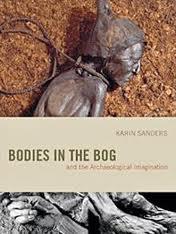Berkeley Books: ''Bodies in the Bog and the Archaeological Imagination'' by Karin Sanders

This month in Berkeley Books we are delighted to feature Bodies in the Bog and the Archaeological Imagination, by Karin Sanders, Professor of Scandinavian.
Bodies in the Bog is a remarkable interdisciplinary study of the afterlives of mummified human artifacts that arrive in the present after stifling for centuries in murky oblivion, preserved by chemicals in bog water and peat. Sanders argues that the discovery of a bog body represents not the culmination of its journey through time, but rather the beginning of a new odyssey, which she follows through the written texts (poems, novels, dramas, and scientific studies) and visual representations (paintings, sculpture, photography, museum displays, and facial reconstructions) that situate it in relation to the archaeological imagination. She writes: “If we think of a bog body as an envelope of frozen time, a corporeal time capsule that rests in quietude for centuries, it is undeniable that this envelope of silence becomes quite eloquent after its excavation” (219).
Tracing the transformation of the human remains first into scientific specimens, museum pieces, and preserved artifacts, and then into visual and literary representations, Bodies in the Bog is not a work of archaeology—though it was awarded William A. Douglass Book Prize Honorable Mention by the Society for the Anthropology of Europe—but a truly interdisciplinary project. Sanders explains:
"This book then is concerned with the textual and visual corpus surrounding the mummified bodies. It is not an archaeological examination but rather an attempt to show how we see, read, and experience these remarkable remains as human time capsules capable of connecting past and present in ways different from other archaeological artifacts. It is about how various discourses (archaeological, literary, political, poetical) imagine bog bodies and make stories about their past and present lives" (xiv)
Sanders shows how bog bodies erode the binaries of time and space, past and present, text and image, ethics and aesthetics, and how our fascination with them transcends the disciplinary boundaries of archaeology, history, literary studies, and art history. Always discovered by accident, their presence alone confounds the traditional three-step archaeological sequence of excavation, classification, and interpretation.
Bogs themselves are deeply liminal spaces, at once wet and dry, solid and soft, firm and malleable. And like the wetlands from which they emerge, centuries after the deaths of the people they once were, bog bodies are profoundly uncanny. They are both human and inhuman, as they seem to suspend the ontological shifts from body to corpse and “from being persons to becoming things, and conversely, from being things to becoming persons” (xv).
Bog bodies have fascinated an impressive roster of writers that includes Carl Jung, Heinrich Himmler, William Carlos Williams, Margaret Atwood, Seamus Heaney, and many others. Studying these writers, as well as bog bodies in visual culture, Sanders finds that: “They have become stand-ins for all kinds of historical atrocities—as Holocaust victims, freedom fighters, victims of sexual discrimination, or people punished for other transgressions” (219). Examining the metamorphoses of the eerily preserved remains into material metaphors for such concepts as trauma, nostalgia, and identity, Bodies in the Bog poses penetrating questions about how we understand time, space, bodies, and the human.
In this week’s Biblio-file, Sanders recommends nine titles that influenced her thinking while working on the book. Her selections, and the account she gives of their role in shaping Bodies in the Bog, present an exciting picture of the development of a richly interdisciplinary project. She describes the fascination P.V. Glob’s The Bog People: Iron Age Man Preserved held for her as a teenager living outside of Copenhagen and the ways in which Susan Sontag’s writing about photography in Regarding the Pain of Others prompted her to think about how distance in time may mitigate disturbing actualities of bog body photographs. In recommending Emmanuel Lévinas’ Entre Nous: Thinking About the Other, she notes that the “face-to-face” metaphor pervades writing about bog bodies, and explains: “The paradox is that the human face, when captured in a plastic form (such as a face reconstruction) can lose the very humanness it proposes to show.” Suggesting The Uncanny and relating an episode from the history of psychoanalysis, Sanders proposes that bog bodies, “locked in the space between the familiar and the unfamiliar” are utterly uncanny. Freud himself, however, was uninterested in the human artifacts—though Sanders notes that this conscious indifference may be at odds with a somatic response: When Jung brought up bog bodies in conversation, Freud fainted!